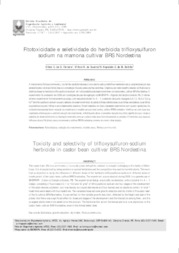Fitotoxicidade e seletividade do herbicida trifloxysulfuron sodium na mamona cultivar BRS Nordestina.
Fitotoxicidade e seletividade do herbicida trifloxysulfuron sodium na mamona cultivar BRS Nordestina.
Author(s): FERREIRA, U. C. DE Q.; QUEIROZ, W. N. DE; BELTRAO, N. E. de M.
Summary: Resumo: A mamoneira (Ricinus communis L.) da família das Euforbiáceas, é uma planta rústica, heliófila e resistente à seca, caracteriza-se por sua sensibilidade a diversos herbicidas e à competição imposta pelas plantas daninhas. Objetivou-se neste trabalho estudar a influência de distintas doses do herbicida trifloxysulfuron-sodium* em vários estádios de desenvolvimento da mamoneira, cultivar BRS Nordestina. O experimento foi conduzido em 2006, em condições de casa de vegetação da EMBRAPA - Algodão de Campina Grande, PB. O delineamento experimental foi inteiramente ao acaso, com esquema fatorial 4 x 4 + 1, constando de quatro dosagens 5,0; 7,5; 10,0 e 12,5 g ha-1 de trifloxysulfuron sodium e quatro estádios do desenvolvimento da planta (folhas cotiledonares, duas folhas verdadeiras, duas folhas expandidas e quatro folhas) e uma testemunha absoluta. Foram testados, no total, dezessete tratamentos com quatro repetições. As variáveis mensuradas foram redução de crescimento e matéria seca da mamoneira, cultivar BRS Nordestina. Verificou-se, com base nos resultados obtidos para a variável redução de crescimento, refletida pela altura e tamanho das plantas, efeito significativo por doses e estádios do desenvolvimento e a interação entre eles, em que a planta mais nova foi mais sensível ao produto. O herbicida que atua nas folhas e raízes é fitotóxico para a mamoneira, cultivar BRS Nordestina, mesmo na menor dose testada. Abstract: The castor been (Ricinus communis L.) is a rustic plant, heliophile, resistant to drought, belonging to the family of Euforbiace. It is characterized by being sensitive to several herbicides and the competition imposed by harmful plants. This work had as objective to study the influence of different doses of the herbicide trifloxysulfuron-sodium in different states of development of the castor been, cultivar BRS Nordestina. The experiment was conducted during 2006, in a greenhouse of EMBRAPA - Cotton at Campina Grande, PB. The experimental design was totally randomized, with a factorial 4 x 4 + 1 design, consisting of four doses 5.0; 7.5; 10.0 and 12 g ha-1 of trifloxysulfuron sodium and four stages of the development of the plant (leaves cotyledon, two true leaves, two expanded leaves and four leaves) and an absolute control. In total 7 treatments were tested with four repetitions. The variables measured were growth reduction and dry matter of the castor been of the to cultivar BRS Nordestina. It was verified, for the variable growth reduction, reflected by the height and size of the plants, that there was a significant effect for doses and stages of the development and the interaction among them, and the youngest plants were more sensitive to the product. The herbicide that acts in the leaves and root, was phytotoxic to the castor been, cultivar BRS Nordestina, even in the lowest tested dose.
Publication year: 2009
Types of publication: Journal article
Unit: Embrapa Cotton
Keywords: Crescimento, Dry matter content, Growth factors, Mamona, Matéria Seca, Redução, Ricinus Communis
Observation
Some of Embrapa's publications are published as ePub files. To read them, use or download one of the following free software options to your computer or mobile device. Android: Google Play Books; IOS: iBooks; Windows and Linux: Calibre.
Access other publications
Access the Agricultural Research Database (BDPA) to consult Embrapa's full library collection and records.
Visit Embrapa Bookstore to purchase books and other publications sold by Embrapa.

